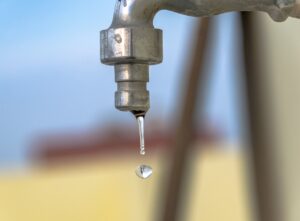Updated November 2024.

Living in the Midwest, we know that dangerous cold snaps can happen at any time from late fall through mid-spring. Suddenly plunging temperatures can cause a major problem for homeowners: frozen water pipes. When water freezes, it expands, and this expansion can cause pipes to burst, potentially damaging a home’s plumbing system, ruining possessions and generally making a big mess. Are your water pipes protected?
When frozen water pipes burst, expensive insurance claims happen
A burst water pipe can cause more than $5,000 in damage, according to Hanover Insurance. That’s why it is important to prevent pipes from freezing in the first place.
Take these steps to avoid the stress, expensive cleanup costs, and unnecessary insurance claims resulting from frozen water pipes:
Check and insulate pipes. Use fiberglass or foam pipe insulation to cover exposed pipes, especially those in unheated areas such as the basement, attic and crawl space. Pay special attention to pipes near exterior walls, as these are more susceptible to freezing. Be sure to follow the manufacturer’s instructions when installing insulation products. Another option is to install heating cables or heat tape on the pipes. These devices provide additional warmth to the pipes and help prevent freezing. If using a heating cable, ensure it is UL-certified and that it has a built-in thermostat that turns the heat on when needed.
Additionally, check exposed pipes carefully for cracks and leaks and get those repaired as soon as possible. Another good idea is to install an emergency pressure-release valve in your plumbing system. The valve will protect against increased pressure in the pipes and prevent them from bursting.
Add extra insulation. Insulate attics, basements and crawl spaces to maintain a warmer environment around pipes.
Seal leaks. Inspect for, and then caulk and seal, any gaps, openings, or cracks in walls, along the foundation, or on the exterior of your home. Install weather stripping around windows and doors to prevent cold air from entering and reaching the pipes. Make sure there are no air leaks in the areas where pipes are located.
Maintain a consistent temperature. Keep a consistent temperature in your home, especially during extremely cold weather. Aim for a minimum of 55°F (13°C), even when you are away. This helps keep the pipes warm enough to prevent freezing. If you are leaving for an extended period (snowbirds and frequent travelers, we mean you!) during cold weather, consider draining the water system or turning off the main water supply and opening all faucets to drain the remaining water.
Open cabinet doors and let faucets drip. During extremely cold weather, open cabinet doors under sinks to allow warm air to circulate around the pipes. This is particularly important for pipes located along exterior walls. Allow faucets connected to vulnerable pipes to drip slightly. This can relieve pressure in the pipes and prevent freezing. Running water, even at a trickle, is less likely to freeze.
Disconnect and drain outdoor hoses. Disconnect and drain outdoor hoses before winter. If possible, shut off the water supply to outdoor faucets and leave them open to allow any remaining water to drain out. Consider installing frost-free hose bibs, especially in areas where the temperature regularly drops below freezing.
Service your heating system. Ensure that your heating system is in good working order. Regular maintenance, including cleaning and inspections, can help prevent unexpected breakdowns during cold weather.
Be proactive and prepared for an emergency. Monitor weather forecasts and take preventive measures when extremely cold temperatures are expected. Familiarize yourself with the location of the main water shut-off valve in your home. If your pipes do freeze, shutting off the water supply can help prevent or minimize a water disaster. The faster you can shut off the water or direct your plumber to the problem, the more likely you will prevent pipes from bursting, or at least reduce the damage.
Seek professional help. If you are unsure about how to handle frozen pipes or if you are unable to prevent them, consider seeking professional advice or assistance.
Address frozen water pipes immediately
If you turn on a faucet during a cold spell and only a trickle of water comes out, the pipe is most likely frozen. In the event pipes do freeze, it is important to thaw them carefully to avoid bursting. You can use a hair dryer, heat lamp, hot towels, or a space heater to thaw the pipes gradually. Avoid using open flames or high-heat devices, as they can damage the pipes or pose a fire hazard. If you are unable to thaw the pipes or if they have burst, contact a professional plumber for assistance immediately.
Does insurance cover burst pipes?
Most homeowner insurance policies cover damage that happens from a burst pipe. Accidental water damage is often part of dwelling coverage, personal property coverage, and loss-of-use coverage (also known as additional living expenses), according to Travelers Insurance. Coverage can include repairing and replacing wood floors, drywall and furniture. Often mold remediation is covered as well, from sudden, unexpected water damage, such as burst pipes. Call your Bradish agent to review your policy and answer any questions you may have about water-damage coverage.
By taking the proper preventive measures, you can reduce the risk of frozen water pipes and the associated problems that can arise from bursting pipes and water damage. If you suspect your pipes are frozen, it is essential to correct the problem promptly to avoid further damage. When in doubt, call a professional!
Sources:
by Kris A. Mainellis